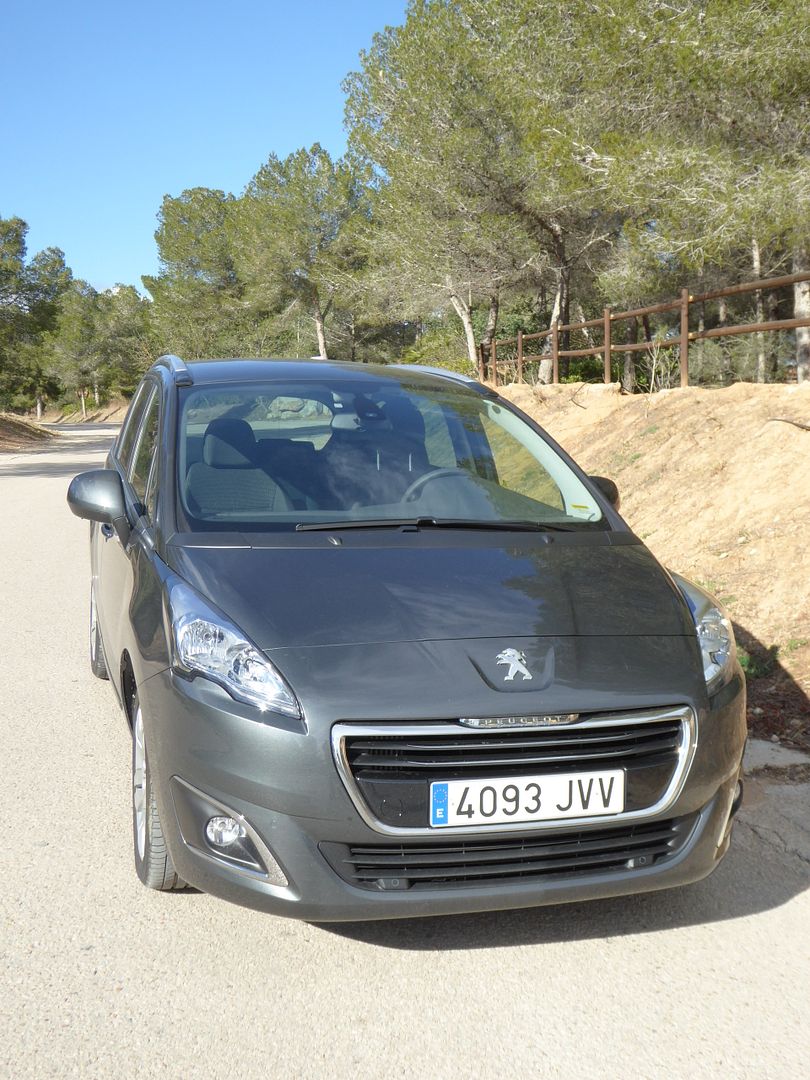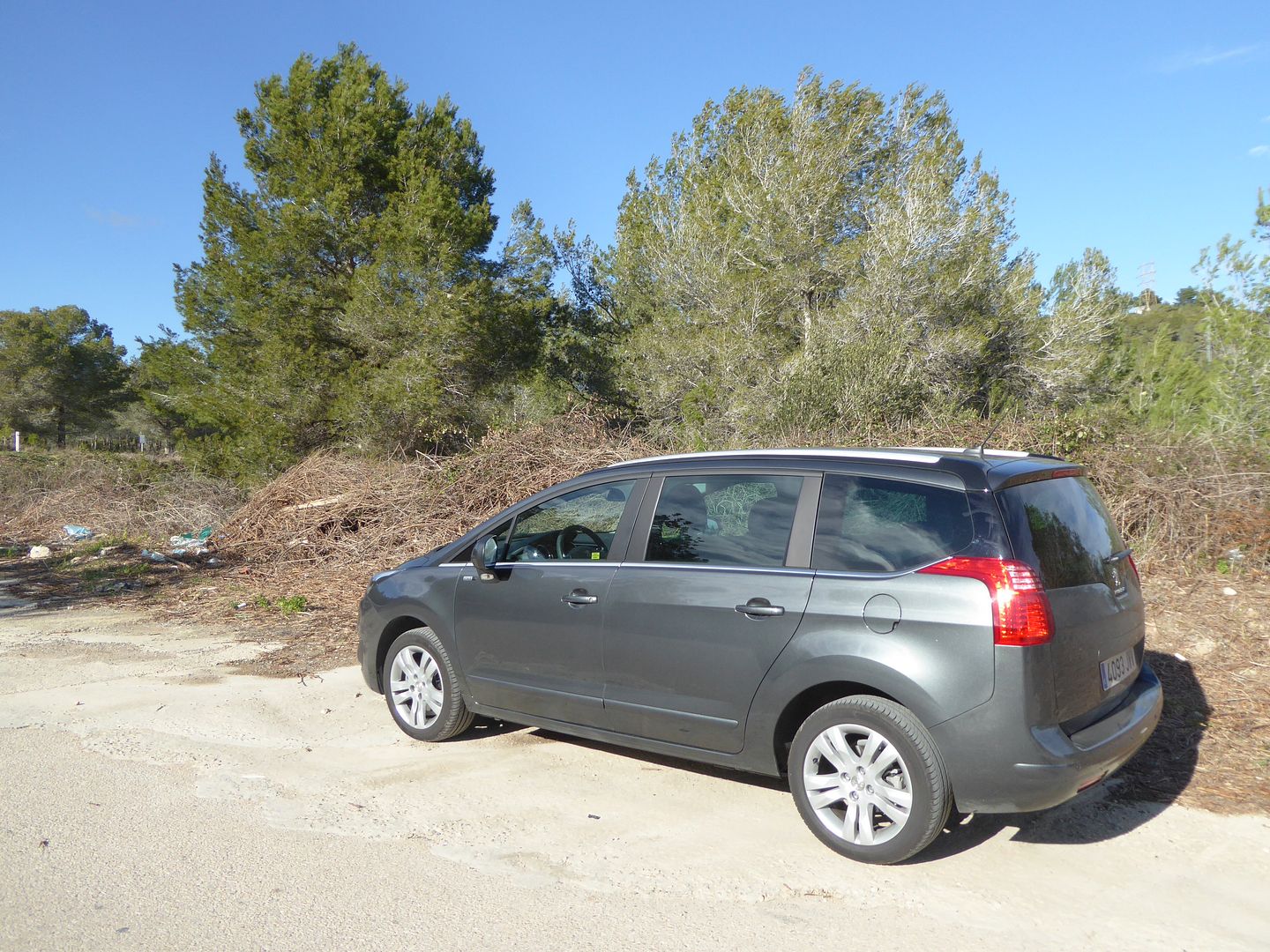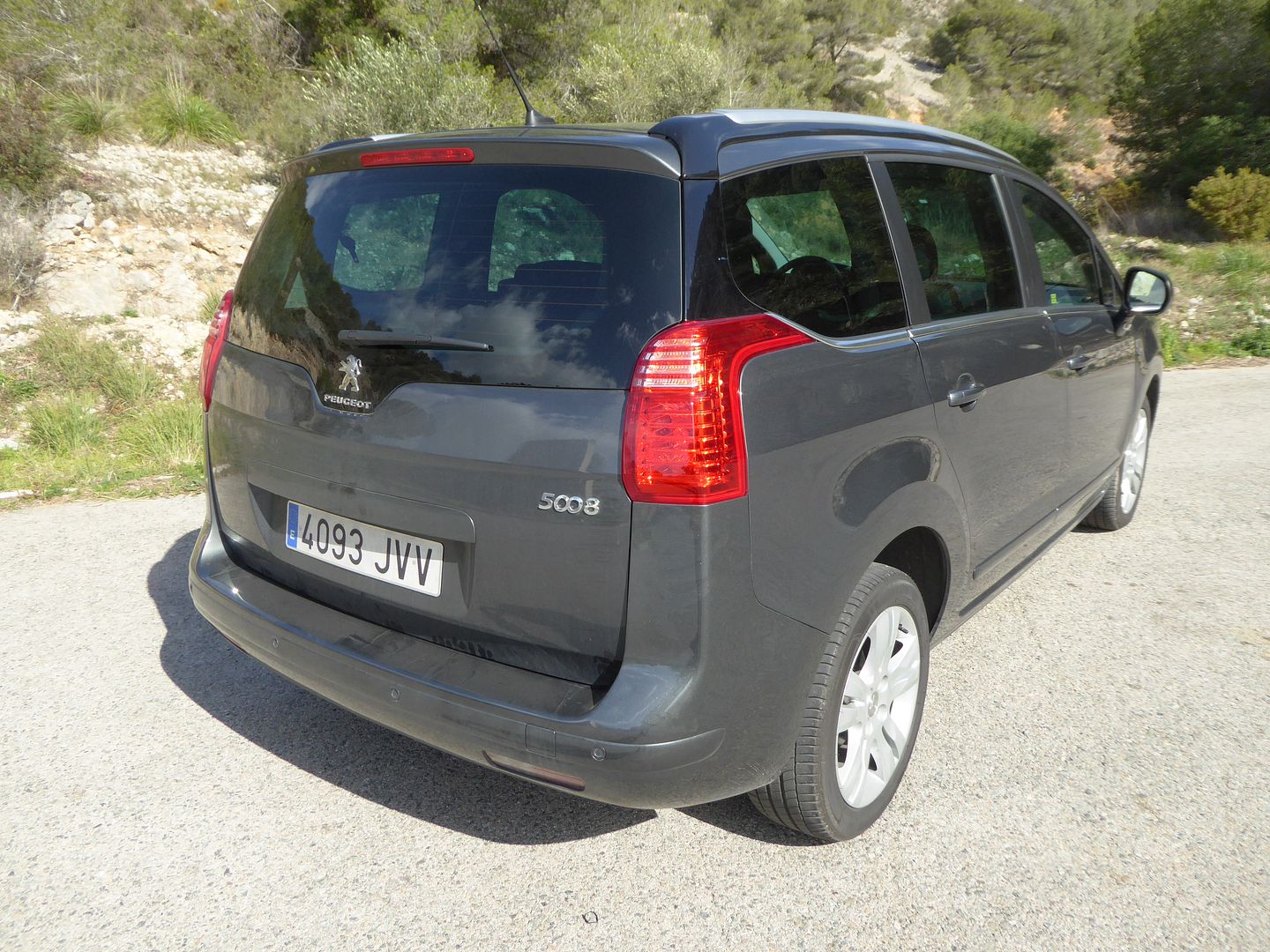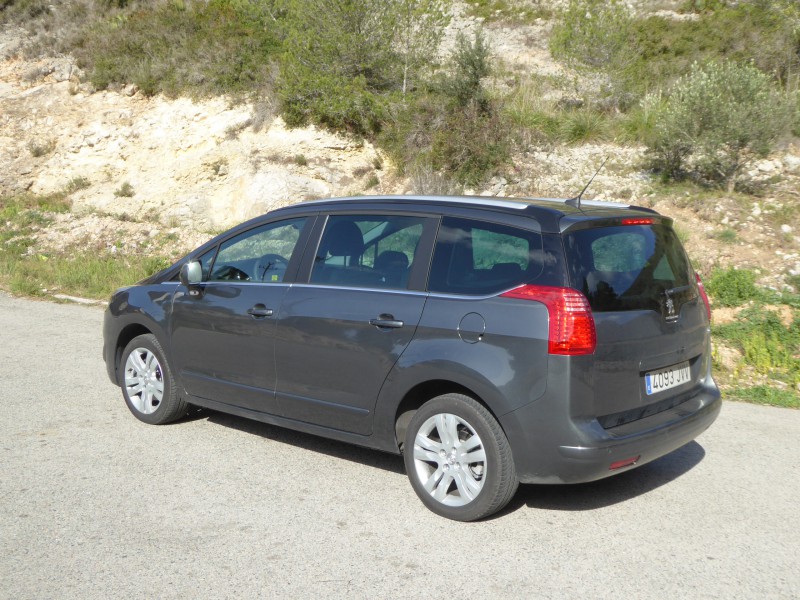































A large sticker on the fuel flap and the word “Diesel” in red across the label on the key fob told me that I would need to refuel this 5008 from the black pump. And this information might almost have been necessary as the 1.6 BlueHDi engine in this car is sufficiently refined that you might otherwise have been a little unsure. Generating 120 bhp, it is pleasantly quiet when you start it up, with none of the characteristic diesel noise which I have now got used to with my own car – which I must say is far more obviously diesel (it pains me to admit!). Underway, the tell-tale sounds of a derv drinker are also pretty well suppressed, showing how, despite the current hate campaign associated with emissions, diesel has become a fuel type which requires no real sacrifices over petrol. 120 bhp is not a huge amount for a car of this size and weight, but it is enough to ensure that this Peugeot can keep up with the traffic flow. You will need to use the gears quite a lot to get the best out of it. And for the first time in a long while in a Peugeot-Citroen product, that is no hardship. After years of encountering their vehicles endowed with vague and sloppy gearchanges, it was a real pleasure to get one where there is the sort of precision that you need and expect. You get a six speeder as standard. Sixth is only really useful for steady speed on the autopista, as I found that below about 85 km/h, the engine laboured too much for this to feel natural or comfortable. By contrast, first is a gear for getting underway and not a lot more. There is quite a narrow band of torque, so when I took the 5008 on the splendid C-31 road that hugs the coast between Barcelona and Sitges, there was an awful of going from 2nd to 3rd and back again, as the combination of hills, tight bends, traffic and cyclists necessitated. Rev the engine closer to the red line and it gets a bit gruff, but at lower revs, it is pleasingly quiet which is just as well as this is not a car that you would ever select for the joy of the sound of its engine. There is a Stop/Start system which cut in and out very effectively. I spent little time in traffic, so it would not have had much effect on fuel economy, which worked out over a test distance of 462 km or 288.75 miles at 48.08 mpg, a commendable but not exceptional figure.
That bendy road proved that this is not a car you would select for the joy of driving, either. At least there is a nice leather wheel to hold, and unlike more recent Peugeot models, this one is a full-size and all the better for that. The steering is light but not to the point of lacking feel, but something with the precision of a Ford or a Mazda, this is not. There is some body roll evident even at moderate speeds and you will also soon find out that it understeers as you head into the bends at anything other than low speeds, but that is probably all intentional, as this is not a sporty car intended for the driver to hurl it around. What will impress far more is that the ride – albeit, Cataluyna’s smooth roads are not necessarily the sternest test – proved to be very good, with the car well damped and feeling composed as it progressed along. There were no concerns with the brakes, with a nice feel to the pedal. There is a cursed electronic handbrake, which was sometimes jerky to release, whether you pressed the button or relied on it to do so as you moved away, and the car was prone to rolling forward or back as you set it unless your foot was very firmly on the footbrake. Visibility was good. There’s a generous glass area, though the steeply sloping windscreen pillars can obstruct at side junctions. Judging the back end is easy, as the rear of the 5008 is near vertical, and in any case there are all-round parking sensors, which also beeped quite a lot when manoeuvering in tight car parks (which you get, starting with getting out of the airport!).
Inside, things are much better than they have been in recent Peugeot years, too. The materials are well chosen, they fit together and there is a nice soft touch to the pleasingly-grained plastics which constitute the majority of the vast dashboard assembly. This really is huge, thanks to the steeply shaped windscreen. Some textural relief comes from the use of a very dark inlay around the centre console and some cloth on the door casings around the armrests. Sitting infront of the driver is a proper-sized steering wheel, with leather wrap. There are no buttons on the boss at all, but there is an audio repeater stalk to the lower right of the regular column stalk that operates the wipers. It helps to contribute to a relatively uncluttered look. The instruments are grouped together under a single cowl. The larger pair, at the edges of the binnacle, and chrome-ringed, are for the rev counter and speedo, with a smaller duo of water temperature and fuel level sat in the upper portion between them, with the lower part reserved for the odometer and trip functions. The central part of the dash curves upwards from the raised centre console area which houses the gearlever, mounted up high so it falls nicely to hand. Under the twin central air vents is a small and now rather old-school audio display unit, beneath which are the rather small buttons used to operate it. This is in-car entertainment of a few years back, with only very limited information other than the audio functions displayable on the unit. Beneath this are the controls, a mix of knobs and buttons, for the tri-zone climate control. Lights are controlled from the end of the left hand column stalk. A row of less used functions, such as disabling Stop/Start are on a bank of switches to the lower left of the wheel. And that is it. It is refreshingly uncluttered looking, and easy to use.
Getting in the 5008, there is no sensation that this is anything other than a regular passenger car, but once installed, you do feel to be sitting that bit higher than you would in a 308 Hatch. Even with the seat ratcheted down to its lowest setting, which is how I needed it, you have what is often referred to as a raised driving position. Seat adjustment is all manual, with a bar under the cushion for fore/aft and a lever on the side of the seat for stepped backrest adjustment. The column goes in/out as well as up/down. Hallejulah that it goes high enough to clear the instruments, unlike the regrettable set-up which Peugeot is now inflicting on everyone claiming that people “like it”, even though most clearly don’t! The seats were covered in a sort of cloth material, with a patterned central area. They proved comfortable in the time I was sitting on them.
There are three rows of seats in this version of the 5008. The middle ones are split into three separate seats and each can be adjusted independently. They are on sliders, with a good few inches fore/aft travel possible. Set well back, there are generous quantities of leg and foot room available. Push the front seat well back and set these well forward, though, and things will get a bit tight. There is a lot of headroom, thanks to the tall styling of this Peugeot. As ever, things are not quite so good for those in the rear-most row. There are two seats here, which pull up out of a well in the boot by pulling a loop on what becomes the backrest. As seats of this type go, these are among the better ones, as there is sufficient of a well in front of them for passenger’s legs to avoid that “knees in chin” feeling you get. Sadly though, unless the middle seats are well forward, you will find your knees are jammed into the back of the seats in front. Whilst there is enough shoulder room, headroom was less generous and even I, who am not tall, found that my head was barely clear of the rooflining. So not really a place for adults for long journeys. Getting in is not as hard as it is in some cars of this type, though with the middle row of seats pulling well forward and out of the way.
With the rearmost seats erect, there is very limited boot space indeed. Enough for a small bag placed vertically, though there is a bit of room under the floor area, useful for odds and ends. With the rear-most seats down, the boot is a good size, nice and regular in shape, with a roll-out luggage cover to hide the contents from prying eyes. Fold the central row down as well, and you get a vast cavern of an area, with a flat floor. Inside the cabin, the glovebox is a bit on the small size, lacking depth, but there is a deep cubby between the seats and there are smaller ones on the dash above the driver’s left knee and a recess in the centre of the dash which would take a few coins as well as a much larger drop down “shin bin” over the driver’s right knee. There are bins on all four doors and ones in the side mouldings alongside the rear-most seats. Central row occupants also get map pockets in the front seat backs and there are fold down picnic tables on the back of the front seats.
When I went online to try to find out more details of the different trim versions and their specification, in Spain, I drew not quite a complete blank, but not far off it, as every source seemed to have switched to the new model. I did manage to find the colour selections with little difficulty, and what a drab bunch they are. As well as black and white, you can have this generation 5008 in a series of shades of grey and that’s about it. From a selection of not dis-similar shades, I think the test car was what UK buyers know as Shark Grey, and in Spain seemed to be called Gris Shark (!). The actual trim version of the test car was not in doubt, as there were badges on the front wings and on the door kick plates. It is called a “Style”, which some may consider to be one of those oxymoronic labels, as, let’s be honest, there’s not much in the way of “style” about this car. However, it does come with most of the essential items of kit included. These include 17″ alloys, front fog lights, roof rails, folding mirrors, all-round parking sensors, tri-zone climate control, an AM/FM radio with CD player. CD, AUX, MP3 and Bluetooth with repeaters on a column stalk, side window sun shades and picnic tables on the back of the front seats. Available engines since the late 2013 facelift include the larger 2 litre HDi unit in 160 bhp guise as well as the petrol 1.2 PureTech 130 bhp and 1.6 THP 165 bhp units. Some versions are available with an automatic gearbox, and most have a choice of 5 or 7 seats. It would seem that there were 4 trims offered in Spain: Access, Active, Style and Allure.
You could never get excited about the 5008. It is not that sort of car. But it is practical, and it turned out to have no serious weaknesses. It is spacious and practical, without making the driver pay an undue price from behind the wheel, with decent enough driving characteristics. It is not without rivals, with two of the strongest coming from its own native land. Although you might not guess by looking at it, the Citroen C4 Grand Picasso shares much under the skin and from my own experience is also a competent machine, and probably better value than the Peugeot. Arch-rival Renault offers the Grand Scenic, and other 7-seaters include the gawky looking Ford Grand C-Max, the rather dull Toyota Verso, the Kia Carens, Vauxhall’s Zafira and maybe even Skoda’s new Kodiaq. I’ve not sampled any of these apart from the Toyota, and suspect each has its own strength. Which is best is a question I cannot answer from personal experience, but I can say that the 5008 is proof that Peugeot has indeed recovered from its 15 years in the wilderness during which time it would certainly not have got anywhere near any podium of merit.








































































